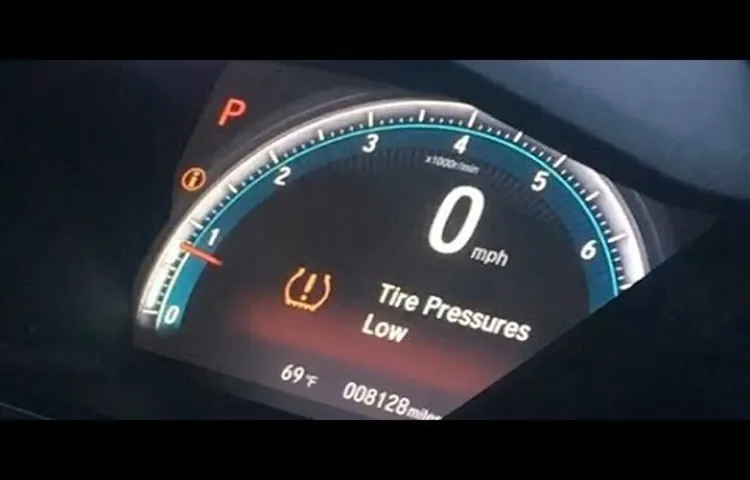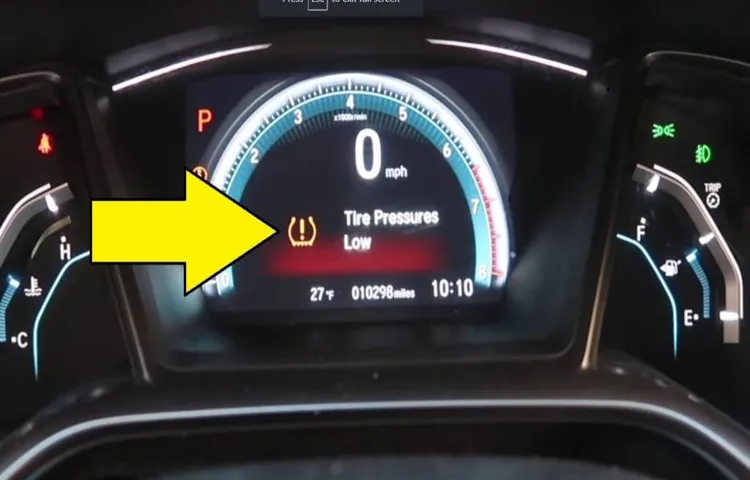As a car owner, one of the most important things you can do for your vehicle is to check your tire pressure regularly. Doing so not only ensures your safety on the road but also improves the overall performance and efficiency of your car. But with the 2020 Honda Civic’s complex tire pressure monitoring system, checking the tire pressure can be a bit daunting for some.
Don’t worry, though – it’s a straightforward process that anyone can do at home with the right tools and knowledge. In this blog post, we’ll walk you through how to check the tire pressure on your 2020 Honda Civic step by step. From locating the tire pressure monitoring system to checking the pressure correctly, we’ve got you covered.
So, let’s dive in and take control of your car’s tire pressure together!
Table of Contents
Why is Tire Pressure Important?
Knowing how to check tire pressure on a 2020 Honda Civic is essential for keeping your car running efficiently and safely. Adequate tire pressure is crucial because it directly impacts the car’s handling, fuel economy, and overall safety. Low tire pressure can cause poor handling, decreased fuel efficiency, and, in severe cases, blowouts, putting passengers at risk.
Conversely, over-inflated tires can negatively affect handling, braking performance, and cause uneven tire wear. To check your tires, use a tire pressure gauge to check pressure levels and make sure there aren’t any visible cuts, punctures, or bulges. Keeping your tires adequately inflated will help you get the most out of your vehicle, boost its fuel efficiency, and extend its lifespan, while also ensuring your safety and that of your passengers on the road.
Improves Fuel Efficiency
Tire pressure is an important factor in improving fuel efficiency. Maintaining the correct air pressure in your tires can help you save money at the pump by reducing the amount of fuel your car consumes. When tires are underinflated, it creates more resistance between the road and the tire.
This extra resistance causes your engine to have to work harder to move your vehicle, which in turn results in an increase in fuel consumption. Overinflated tires can be just as detrimental to your fuel economy. They can lead to uneven wear on your tires, which can decrease the longevity of your tires and create a less fuel-efficient driving experience.
By regularly checking and maintaining the air pressure in your tires, you can improve your car’s gas mileage and save money in the long run. It’s a small effort that can make a big difference to your pocketbook and the environment. So, the next time you get behind the wheel, make sure you check your tire pressure for a smoother, more efficient ride.

Enhances Tire Life and Safety
Tire pressure is an essential factor that significantly influences our vehicle’s performance, fuel efficiency, and, most importantly, safety. Adequate tire pressure enhances tire life and safety, reducing the risks of accidents and unexpected breakdowns on the road. When a tire has low pressure, it cannot grip the road properly, negatively affecting the steering and braking.
Moreover, low tire pressure can cause the tires to heat up excessively, which can lead to blowouts or punctures. On the other hand, overinflated tires can reduce the traction and stability of the vehicle, decreasing the life of the tires. Therefore, it is crucial to regularly check and maintain the tire pressure to ensure optimal performance and safety.
Keeping your tire pressure at the recommended level by the manufacturer can extend the tire’s lifespan, provide better fuel economy, and ensure a comfortable and smooth ride. Remember, ensuring adequate tire pressure is a simple measure that can have a massive impact on your driving experience.
Things You Need to Check Tire Pressure
If you’re a proud owner of a 2020 Honda Civic, monitoring your tire pressure regularly is crucial to maintain your car’s optimal performance, efficiency, and safety. To check your car’s tire pressure accurately, you need a tire pressure gauge, which you can purchase from any auto parts store or online. Once you have the gauge, remove the valve cap from your tire and firmly press the gauge onto the valve stem.
The gauge will give you a reading in PSI, which you can compare with your car’s recommended tire pressure, stated either in the owner’s manual or on the label inside the driver’s door. If the reading shows that your tire pressure is below the recommended level, inflate the tire with the correct amount of air until the pressure matches the recommended level. Checking your tire pressure regularly is a simple and inexpensive way to ensure that you’re driving your Civic safely and efficiently.
A Tire Pressure Gauge
As a car owner, it’s important to keep your tires properly inflated. Not only does this help to extend the life of your tires, but it also improves your car’s fuel efficiency and handling. To check your tire pressure, you’ll need a few things.
First, make sure you have a tire pressure gauge on hand. This is a small tool that allows you to measure the air pressure within your tires. You’ll also need to consult your vehicle’s owner manual to find the recommended tire pressure level for your specific make and model.
Once you have both of these things, it’s time to start checking your tire pressure. Remove the valve cap from the tire and press the gauge onto the valve stem. You should hear a brief hiss of air as the gauge takes the reading.
Compare the reading on the gauge to the recommended pressure level in your owner manual. If the reading is lower, add air to your tire until you reach the recommended level. Using a tire pressure gauge is a simple way to help you maintain your car’s safety and performance on the road.
A Source of Air
Tire pressure is a critical aspect of vehicle safety that is often overlooked. It is recommended that you check your tire pressure at least once a month. To do so, you’ll need a source of air, such as an air compressor or a gas station air pump.
Once you have the necessary tools, you should begin by referencing the owner’s manual for your specific vehicle. The recommended tire pressure can vary based on the make and model of your car. If you don’t have access to the manual, you can usually find the recommended tire pressure on a sticker located on the driver’s side door jamb.
When checking tire pressure, it’s important to be mindful of temperature changes. When the temperature drops, tire pressure can decrease, and when it rises, tire pressure can increase. Keeping your tire pressure at the appropriate level can not only improve safety but also provide better fuel efficiency.
Remember to prioritize checking your tire pressure regularly to ensure a safer driving experience.
Steps to Check Tire Pressure on 2020 Honda Civic
Maintaining proper tire pressure is crucial for your safety and the longevity of your 2020 Honda Civic’s tires. Checking tire pressure is a relatively straightforward process that can be done in just a few minutes. First, locate the tire pressure label on the driver’s door jamb, which provides the recommended tire pressure for your vehicle.
Next, remove the valve cap on the tire and use a tire pressure gauge to measure the pressure in the tire. Compare the reading with the recommended tire pressure and adjust the pressure accordingly by adding or releasing air as needed. Once you’re done, replace the valve cap and repeat for all four tires.
It’s important to check tire pressure regularly to ensure optimal performance and fuel efficiency. So, make it a habit of checking your tire pressure at least once a month, or more often if you frequently drive in changing weather conditions. By doing so, you’ll be able to keep your 2020 Honda Civic in excellent shape, and more importantly, ensure your safety on the road.
Step One: Check Ideal Tire Pressure
As a responsible driver, checking your car’s tire pressure should always be on the top of your to-do list, especially when owning a 2020 Honda Civic. The recommended tire pressure for this model is typically found in the owner’s manual or on a sticker located on the driver’s side door jamb. Once you have found the ideal pressure, you need to use a tire gauge to check the air pressure in each tire individually.
Simply press the gauge onto the tire’s valve stem, and the gauge will give you a reading. If the tire pressure is too low or too high, you can either add or let air out until you reach the recommended pressure. Remember, keeping your tires at the ideal pressure not only ensures your safety on the road but also maximizes fuel efficiency and prolongs tire life.
Step Two: Locate Tire Pressure Monitoring System
The next step to checking tire pressure on a 2020 Honda Civic is locating the tire pressure monitoring system. This system will let you know which tire or tires may be low on pressure. On the dashboard of the Civic, you will see a button labeled “TPMS.
” Pressing this button will show the current tire pressure levels on each tire. Keep in mind that the TPMS only displays the pressure, not the amount of air needed to fill the tire to the correct PSI level. This information can be found in the owner’s manual or on a sticker located on the driver’s side door jamb.
Always double-check the recommended PSI level before adding air to your tires. By locating and utilizing the TPMS system, you can quickly and easily determine which tire or tires need attention, ensuring they are properly inflated for optimal performance and safety.
Step Three: Remove Tire Valve Cap
After locating the tire pressure recommendation sticker in your 2020 Honda Civic, the next step in checking tire pressure is to remove the tire valve cap. This cap is typically found on the top of the tire, directly over the valve stem. It is important to remove this cap carefully, to avoid damaging the valve stem or losing the cap altogether.
With the cap removed, you can then use a tire pressure gauge to measure the current pressure in the tire. If the pressure is too low or too high, you can then use an air compressor to adjust the pressure accordingly. Remember to replace the tire valve cap once you are finished checking the pressure, to prevent debris and moisture from entering the valve stem.
By regularly checking and adjusting your tire pressure, you can ensure optimal handling, fuel efficiency, and tire life for your 2020 Honda Civic.
Step Four: Place Gauge on Valve Stem
If you’re unsure about how to check your tire pressure on your 2020 Honda Civic, don’t worry – it’s a fairly straightforward process that can be completed in just a few minutes! Once you’ve located your tire pressure gauge, the next step is to place it on the valve stem of your tire. This can be a bit tricky if you’re not used to it, so take your time and make sure you’re aligning the gauge properly. Once you’ve successfully attached the gauge, take note of the pressure reading and compare it to the recommended PSI for your vehicle.
If it’s within the acceptable range, you’re good to go! If it’s too low or too high, you’ll need to adjust the tire pressure accordingly. Remember – maintaining proper tire pressure is crucial for both safety and optimum performance!
Step Five: Record Reading and Add Air as Needed
After checking the tire pressure on each tire of your 2020 Honda Civic, you need to record the readings and add air if necessary. It’s always a good idea to keep a record of your tire pressure readings in your car’s manual or maintenance log. This way, you can see how often you need to check the tires and how much air to add if necessary.
If any tire has a lower reading than the recommended psi level, you need to add air. Use an air compressor to add air to the tire, making sure to check the pressure frequently to avoid overinflating the tire. An overinflated tire can be just as dangerous as an underinflated one, so it’s crucial to get it right.
Once you’ve added the air, check the tire pressure again to ensure it’s at the recommended level. Remember that keeping your tire pressure at the recommended level not only improves your vehicle’s performance but also contributes to road safety.
Step Six: Replace Valve Cap and Repeat for Other Tires
Checking your tire pressure is an essential maintenance task that can extend the life of your 2020 Honda Civic’s tires and improve your car’s fuel efficiency. To do this, you must follow a few simple steps. First, locate your car’s tire pressure specification, either in the owner’s manual or on the driver’s side door jamb.
Next, unscrew the valve cap and press a tire pressure gauge onto the valve stem. Be sure to take three readings for each tire and average them out to get an accurate measurement. If the tire pressure is low, add air with a portable compressor or at a gas station.
Finally, replace the valve cap, and repeat the process for the other tires, ensuring each tire matches the recommended PSI. With these simple steps, you can keep your 2020 Honda Civic’s tires properly inflated, preventing uneven wear, and reducing the likelihood of a flat tire.
Conclusion
So there you have it, folks! Checking the tire pressure on your 2020 Honda Civic might seem like a simple task, but it’s one that shouldn’t be overlooked. Just remember to find the recommended PSI in your car’s manual, use a reliable tire pressure gauge, and don’t forget to check all four tires (yes, even the spare). And who knows, once you master this skill, you might even impress your friends with your tire pressure prowess at your next social gathering.
Or, you know, just continue to enjoy the smooth and fuel-efficient ride that comes with properly inflated tires. The choice is yours!”
Checking tire pressure is an essential aspect of maintaining your Honda Civic’s longevity and safety.
Maintaining proper tire pressure is crucial for ensuring your 2020 Honda Civic’s longevity and keeping you safe while on the road. Luckily, checking your tire pressure is a simple process that you can do at home with minimal equipment. The first step is to find the recommended tire pressure for your specific model, which can be found in the owner’s manual or on the driver’s side door jamb.
Once you have this information, use a tire pressure gauge to measure the pressure in each tire and compare it to the recommended psi. If the pressure is too low, use an air compressor to fill the tires to the proper level. It is important to check your tire pressure regularly, as changes in temperature or simply driving can cause it to fluctuate.
Keeping your tires properly inflated can not only improve fuel efficiency and tire life, but it can also prevent accidents caused by underinflated or overinflated tires. So take a few minutes to check your tire pressure today and ensure a safe and comfortable ride in your Honda Civic.
FAQs
What is the recommended tire pressure for a 2020 Honda Civic?
The recommended tire pressure for a 2020 Honda Civic varies based on the model and trim level, but typically ranges between 32-36 PSI for the front and rear tires. Check your owner’s manual for the exact specifications.
How often should I check the tire pressure on my 2020 Honda Civic?
It is recommended that you check the tire pressure on your 2020 Honda Civic at least once a month or before long road trips. Additionally, a sudden change in temperature can affect tire pressure, so it’s a good idea to check it during extreme weather changes as well.
Can I check the tire pressure on my 2020 Honda Civic without any special tools?
Yes, you can check the tire pressure on your 2020 Honda Civic without any special tools. Use a tire pressure gauge, which can be found at most auto stores or online retailers, to measure the pressure in each tire. You can also use the tire pressure monitoring system (TPMS) that comes standard on most models, which will display the tire pressure on the dashboard.
What should I do if the tire pressure on my 2020 Honda Civic is too low?
If the tire pressure on your 2020 Honda Civic is too low, you should add air to the tires until they reach the recommended PSI range. Be sure to use a tire pressure gauge to ensure that the pressure is accurate. If you’re unsure how to add air to your tires, consult your owner’s manual or visit your local auto mechanic.
Is overinflating my tires on my 2020 Honda Civic a good idea?
No, overinflating your tires on your 2020 Honda Civic is not a good idea. It can lead to uneven tire wear, a harsher ride, and potentially even a blowout. Always follow the manufacturer’s recommended tire pressure range.
Can the tire pressure on my 2020 Honda Civic affect gas mileage?
Yes, tire pressure can affect gas mileage on your 2020 Honda Civic. Underinflated tires create more rolling resistance, which can result in lower fuel efficiency. Keeping your tires at the recommended PSI range can help maximize your gas mileage.
Should I keep a tire pressure log for my 2020 Honda Civic?
It’s a good idea to keep a tire pressure log for your 2020 Honda Civic, especially if you frequently travel long distances. It can help you detect any sudden changes in tire pressure and allow you to take preventive measures before a blowout occurs. You can use a simple notebook or a smartphone app to keep track of your tire pressure readings.




